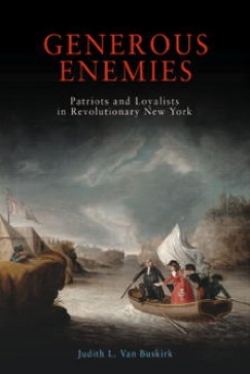Judith L. Van Buskirk, Generous Enemies: Patriots and Loyalists in Revolutionary New York (Philadelphia, Pa.: University of Pennsylvania Press, 2002, $31.76). Pp. 260. ISBN 0 8122 3675 0.
Review first appeared in the Journal of American Studies 37, no. 3 (Dec. 2003), 521-522.
< Back to book reviews listing
Generous Enemies: Patriots and Loyalists in Revolutionary New York
Judith L. Van Buskirk
Reviewed by Michael A. McDonnell, University of Sydney
Accustomed as we have become to the idea of war as being a dangerous, divisive, and thoroughly destructive business, Judith L. Van Buskirk’s findings may surprise many readers. In her study of the American War of Independence, Van Buskirk argues that the lines drawn between opposing sides in the conflict were not so impenetrable as we might have imagined. Focusing her attention on the one bastion of solid opposition to the American patriot cause, occupied New York City, Van Buskirk shows that the communities and people so often depicted as irreconcilable enemies were, in fact, more than generous enemies: hundreds if not thousands of people frequently crossed military lines during the war to help friends and families, socialise, trade, and, in the case of enslaved Americans, seek out opportunities for greater freedom. In this wonderfully well-written book, Van Buskirk unearths a wealth of archival material to construct a compelling social history of a city at war. But instead of finding tales of bloodshed and betrayal, she finds that family bonds trumped partisan causes, personal concerns triumphed over political ideology, and commercial interests overrode military strategy. The lines between contending forces were porous, and the texture of everyday life in the city was much more complicated, she writes, than historians, and the public alike, have admitted. Yet, in her generally successful attempt to correct this perspective, Van Buskirk can be faulted for only hinting at the darker side of war. Her sources perhaps inevitably lead her into the literate world of the elite, who had the means, the connections and the desire to cross the lines and maintain cordial relations (often because there was, of course, property at stake). And yet, as Van Buskirk knows, even while generous enemies held festive dinners together, there existed a largely unseen world of hardship, death, and dislocation. Though lower-class women crossed enemy lines to bring food and solace to soldier-husbands suffering in military prisons, few would have anything generous to say, if asked, about the authors of their misfortune. And Van Buskirk’s own careful analysis of the Major Andre´ affair shows a popular implacable hatred of the British, tinged with a class-based resentment of the very privileges that allowed elites on either side to be generous enemies. Still, Van Buskirk, with her attention to detail, is right to highlight the continuities and connections that often exist between opposing sides in the midst of war, and her subject to the Cambridge chapter on the complexities of enslaved New Yorkers lives during the conflict is a particular treat. Van Buskirk’s work is, of course, a timely reminder that no matter how much politicians on opposing sides want to demonise our enemies, we usually have more in common than not.

